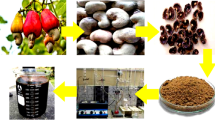Abstract
The structure and mechanical properties of carbonized coconut shell nanoparticles (CSnp) reinforced epoxy composite have been evaluated to establish the possibility of using the composite as a new material for automobile car bumper application. Epoxy resin of the type LY556 was blended together with CSnp at 5–25 wt%. Scanning electron microscopy (SEM), mechanical test, and thermogravimetric analysis (TGA) were examined. SEM morphology reveals adhesion between CSnp and polymer matrix at low wt%CSnp while at higher weight percent of CSnp agglomeration of CSnp was observed. The addition of CSnp at 25 wt% produced the optimal hardness values of 26.35 VHN, tensile stress of 338.75 MPa, and flexural strength of 156 MPa, while at 10 wt% CSnp produced optimal impact energy value of 5.71 J. The developed epoxy composite when compared with two existing Toyota models showed improved impact energy at break of 10.5% over Big Daddy Model and 37.45% over Carina model under the same testing conditions.
Similar content being viewed by others
References
Hassan SB, Aigbodion VS, Patrick SN (2012) Development of polyester/eggshell particulate composites. Tribol Ind 34(4):217–225
Campbell FC (2010) Structural composite materials. ASM International, Novelty, pp 1–30 Compositelab.com/composite-materials/resins, 21th Sept, 2017
Mishra S, Tripathy S, Nayak S (2002) Novel eco-friendly biocomposites, biofiber reinforced biodegradable polyester amide composite-fabrication and properties evaluation. J Reinf Plast Compos 21(1):55–70
Ramachandran M, Bhargava, Rishabh, Raichurkar PP (2016) Effect of nanotechnology in enhancing mechanical properties of composite materials. Int J Text Eng Process 2(1):59–63
Ricciotti L, Roviello G, Tarallo O, Borbone F, Ferone C, Colangelo F, Catauro M, Cioffi R (2013) Synthesis and characterizations of melamine-based epoxy resins. Int J Mol Sci 14:18200–18214
Akindapo JO, Agov ET, Garba DK, Ogabi RO (2017) Comparative assessment of mechanical properties of groundnut shell and rice husk reinforced epoxy composites. Am J Mech Eng 5(3):76–86
Kumar TV, Chandrasekaran M, Santhanam V (2017) Characteristics analysis of coconut shell husk reinforced polymer composites. ARPN J Eng Appl Sci 12(8):2017
Easwara PGL, Keerthi GBS, Velmurugan R (2017) Comparative study of impact strength characteristics of treated and untreated sisal polyester composites. Procedia Eng 173:778–785
Prabhu R, Rahul MP, Aeilias A, Sunny B, Alok J, Bhat T (2017) Investigation of tribological property of coconut shell powder filled epoxy glass composites. Ame J Mater Sci 7(5):174–184
Manjunatha Chary GH, Sabeel Ahmed K (2017) Experimental characterization of coconut shell particle reinforced epoxy composites. JMES 8(5):1661–1667
Somashekhar TM, Naik P, Nayak V, Mallikappa, Rahul S (2018) Study of mechanical properties of coconut shell powder and tamarind shell powder reinforced with epoxy composites. IOP Conf Ser: Mater Sci Eng 376:012105
Agunsoye JO, Talabi SI, Obidiegwu EO, Awe IO (2014) The development and characterisation of epoxy-foundry basic slag particulate composite materials. Int J Compos Mater 4(2):93–102
Sapuan SM, Harimi M Mechanical properties of epoxy/coconut shell filler particle composites. Arab J Sci Eng 28. Number 2B:171–181
Durowaye SI, Lawal GI, Akande MA, Durowaye VO (2014) Mechanical properties of particulate coconut shell and palm fruit polyester composites. Int J Mater Eng 4(4):141–147
Mishra A (2017) Mechanical properties of coconut shell dust, epoxy-fly ash hybrid composite. Am J Eng Res (AJER) 6(9):166–174
Davoodi MM, Sapuan SM, Aidy A, Abu Osman NA, Oshkour AA, Abas ABW (2012) Development process of new bumper beam for passenger car: a review. Mater Des 40:304–313. https://doi.org/10.1016/j.matdes.2012.03.060
Davoodi MM, Sapuan SM, Ali A, Ahmad D, Khalina A (2010) Thermoplastic impact property improvement in hybrid natural fibre epoxy composite bumper beam. IOP Conf Series Mater Sci Eng 11:012013
Author information
Authors and Affiliations
Corresponding author
Rights and permissions
About this article
Cite this article
Agunsoye, J.O., Odumosu, A.K. & Dada, O. Novel epoxy-carbonized coconut shell nanoparticles composites for car bumper application. Int J Adv Manuf Technol 102, 893–899 (2019). https://doi.org/10.1007/s00170-018-3206-0
Received:
Accepted:
Published:
Issue Date:
DOI: https://doi.org/10.1007/s00170-018-3206-0




